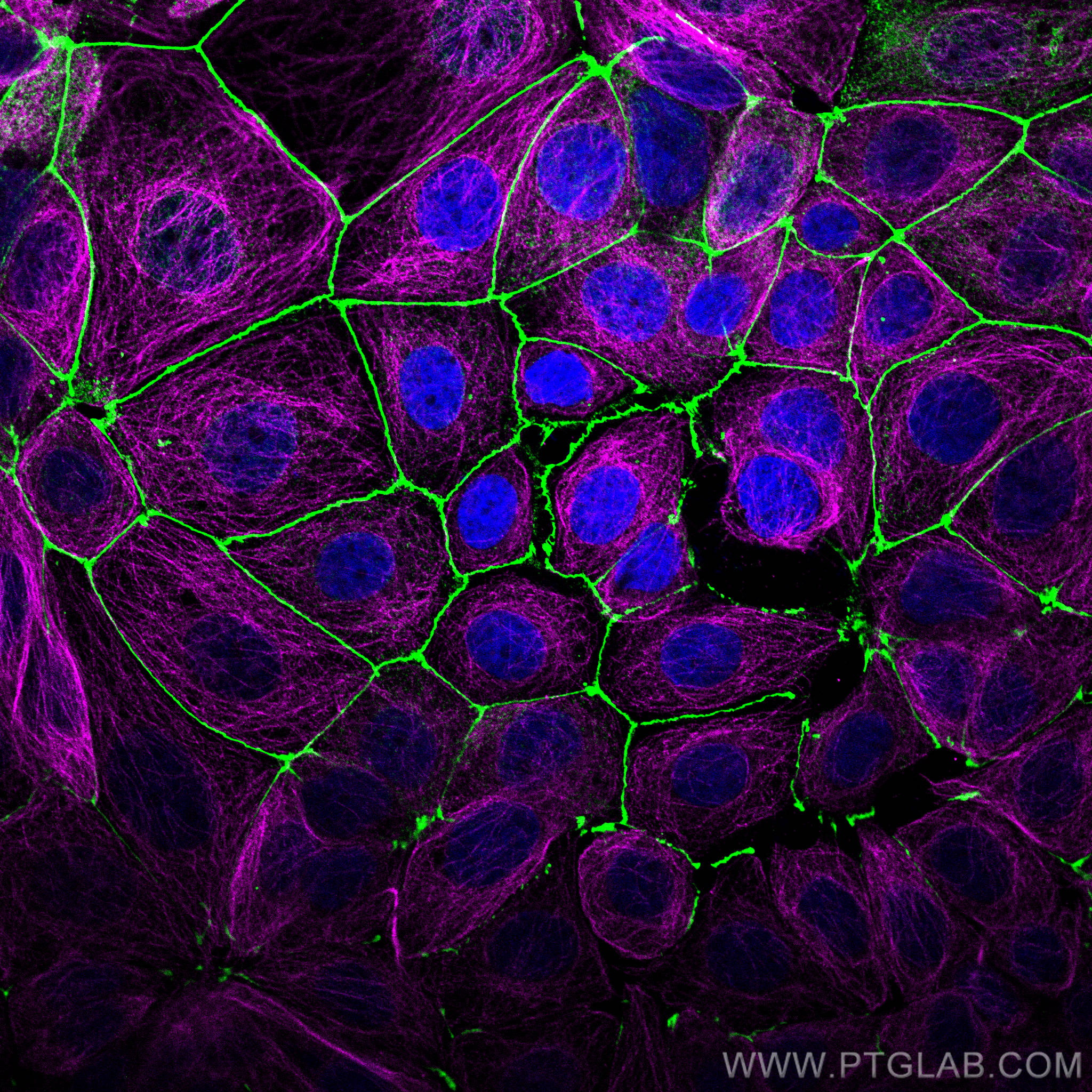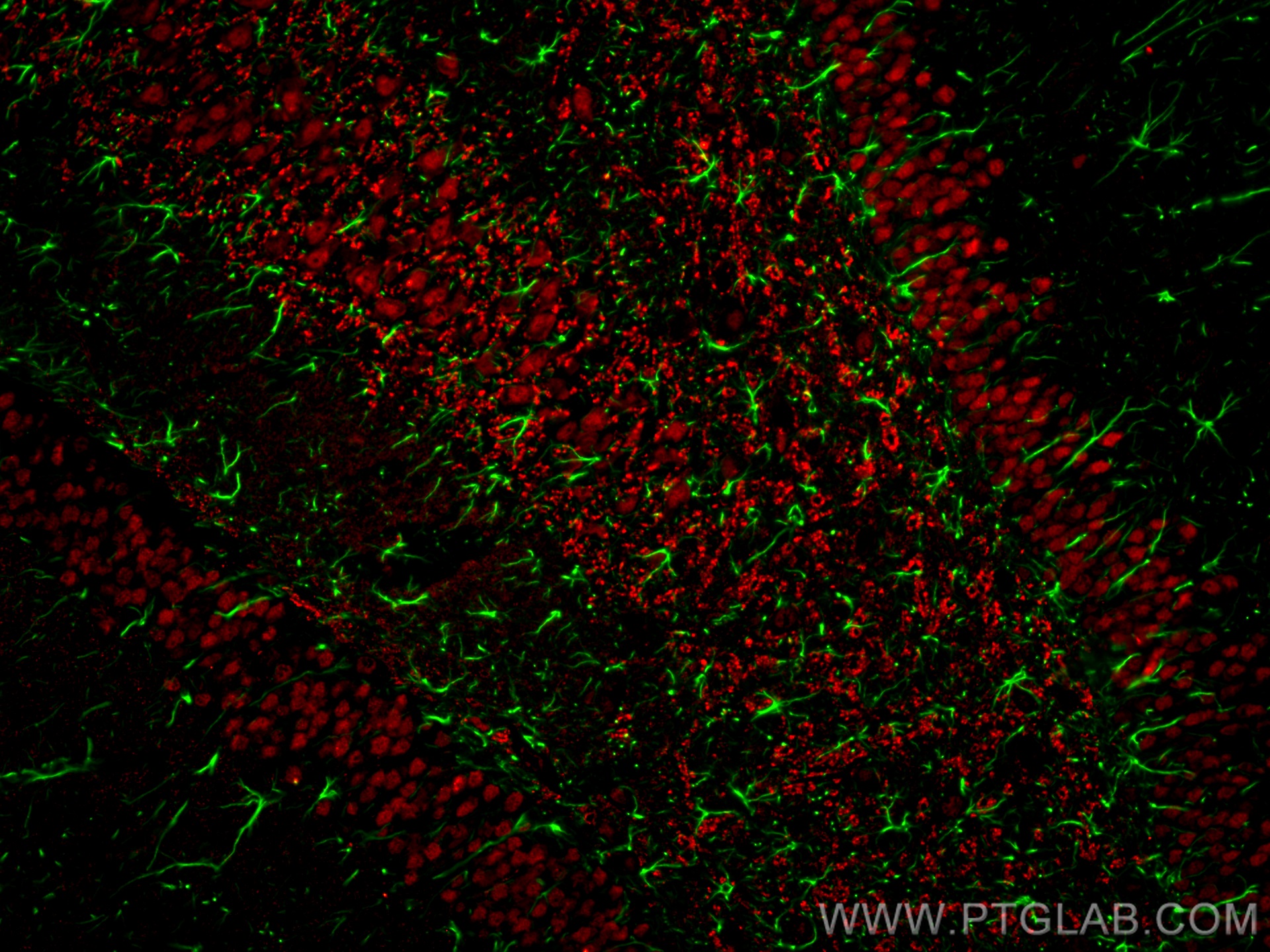How to choose the right secondary antibody?
How to choose the best secondary antibody for your application.
Secondary antibodies facilitate the indirect detection of target molecules by binding to the primary antibody, which in turn binds to the target antigen. Secondary antibodies are generally labeled with a tag to facilitate detection or purification. Indirect detection using conjugated secondary antibodies offers several advantages over the use of directly conjugated primary antibodies, including:
Increased sensitivity – Multiple secondary antibodies binding to a single primary antibody result in signal amplification.
Flexibility – The same secondary antibody can be used to detect multiple targets by pairing with multiple primary antibodies.
More versatile – The same primary antibody can be paired with various secondary antibodies depending on the intended application (e.g., HRP conjugates for western blot and fluorescent conjugates for IF/FC).
Easily available – Secondary antibodies against most species are widely available in a variety of conjugate options from multiple commercial suppliers.

Primary antibodies can be detected by using either conjugated secondary antibodies (indirect detection) or by using directly conjugated primary antibodies (direct detection).
Proteintech offers a comprehensive portfolio of secondary antibodies for detecting unconjugated primary antibodies in a wide range of applications including western blot, ELISA, immunofluorescence, immunohistochemistry, and flow cytometry.
Choosing a Secondary Antibody
The choice of appropriate secondary antibody in an application depends on multiple factors, as highlighted below, to ensure highly sensitive and accurate detection of the target antigen.
1. Target specificity – The secondary antibody must be raised against the host species of the primary antibody. For example, if the primary antibody was generated in mouse, the secondary must be anti-mouse and raised in a host species other than mouse (e.g., goat anti-mouse secondary antibody). In addition, the secondary antibody should be specific for the primary antibody class or subclass. Since most polyclonal primary antibodies are raised against isotype IgG, the secondary antibody used should recognize both IgG heavy and light chains (anti-IgG H+L). Monoclonal primary antibodies on the other hand are raised against specific IgG subclasses, thereby requiring subclass-specific secondary antibodies for their detection.
2. Clonality – Traditionally, antibodies have been classified as polyclonal or monoclonal. While polyclonal secondary antibodies are a heterogenous population of antibodies recognizing different epitopes on the same antigen, monoclonal secondary antibodies are a homogenous antibody population that recognizes the same epitope on an antigen. When deciding on antibody clonality, the choice depends on what is more critical for the intended application – specificity or sensitivity. While monoclonal secondary antibodies have superior specificity compared to polyclonal antibodies and are preferred for applications requiring highly specific target detection (e.g., for detecting specific mouse isotypes), polyclonal secondary antibodies are far more sensitive than monoclonal secondaries and are therefore used for applications requiring high sensitivity (e.g., for the detection of low abundance targets).
Proteintech’s Multi-rAb Recombinant Secondary Antibodies are the newest generation of secondary antibodies that combine the high sensitivity of polyclonals with the superior specificity of monoclonals. Multi-rAb secondaries consist of mixtures of recombinant monoclonal antibodies that recognize multiple complementary epitopes on the same IgG. Each recombinant clone in the final multiclonal antibody mixture is carefully selected after rigorous characterization and screening to ensure minimal cross-reactivity, high brightness, and low background.
|
|
|
|
IF analysis of MCF-7 stained with anti-ZO1 antibody (21773-1-AP, green) and anti-alpha tubulin antibody (66031-1-Ig, magenta). Multi-rAb CoraLite® Plus 488-Goat Anti-Rabbit Recombinant Secondary Antibody (H+L) (RGAR002) and Multi-rAb CoraLite® Plus 647-Goat Anti-Mouse Recombinant Secondary Antibody (H+L) (RGAM005) were used for detection |
IF analysis of rat brain FFPE section stained with anti-GFAP antibody (16825-1-AP, green) and anti-NeuN antibody (66836-1-Ig, red). Multi-rAb CoraLite® Plus 488- Goat Anti-Rabbit Recombinant Secondary Antibody (RGAR002) and Multi-rAb CoraLite® Plus 594-Goat Anti-Mouse Recombinant Secondary Antibody (H+L) (RGAM004) were used for detection. |
3. Host species – The host species refers to the animal in which the secondary antibody was raised. It is important to ensure that the secondary antibody host is different from the host animal in which the primary antibody was raised. While the majority of primary antibodies are raised in rabbits or mice, goats are the most widely used host animals for commercially available secondary antibodies.
When performing multiplex experiments, while it is recommended that all primary antibodies are derived from unique host species, the secondary antibodies used should be raised in the same host species. This helps prevent cross-reactivity between secondary antibodies and primary antibodies from non-target species.
4. Antibody format – Secondary antibodies are available in various formats including whole antibodies and antibody fragments. The choice of the secondary antibody format is dependent on the intended application of the antibody. For example, antibody fragments including F(ab’)2 and Fab’ are preferred over whole antibodies for IHC and IF in tissue samples due to their smaller size since it allows for better tissue penetration. Moreover, since fragment secondary antibodies lack the Fc region, they help eliminate high background resulting from non-specific binding of the Fc region to Fc receptors on certain cell types (B cells, NK cells, macrophages, and dendritic cells), thereby making them highly suitable for use with samples rich in Fc receptors. However, one thing to keep in mind is that fragment antibodies have lower sensitivity compared to whole antibodies since they can bind fewer dye or enzyme molecules due to their smaller size.
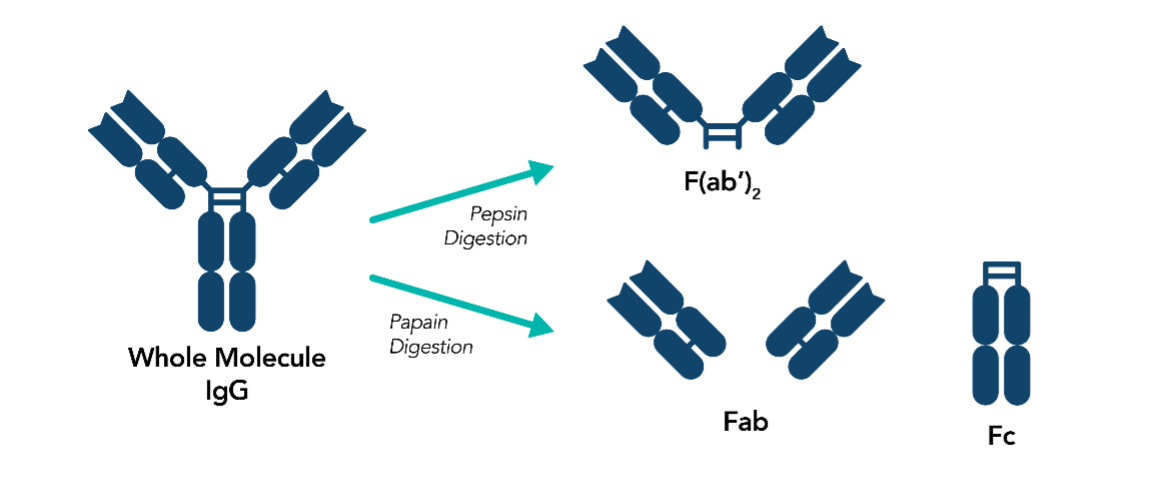
Whole IgG antibodies are digested with pepsin and papain to generate F(ab’)2 and Fab’ fragment antibodies, respectively.
Proteintech offers a novel class of recombinant secondary antibodies known as Nano-secondary reagents that are designed to provide higher resolution, lower background, and cleaner images in super-resolution microscopy applications. Nano-Secondary reagents consist of recombinantly generated alpaca nanobodies/VHHs conjugated to Alexa Fluor® or CoraLite® Plus fluorescent dyes and bind to primary antibodies with high affinity in a species- and subtype-specific manner. Nano-secondary reagents can achieve higher resolution and better tissue penetration due to their smaller size.
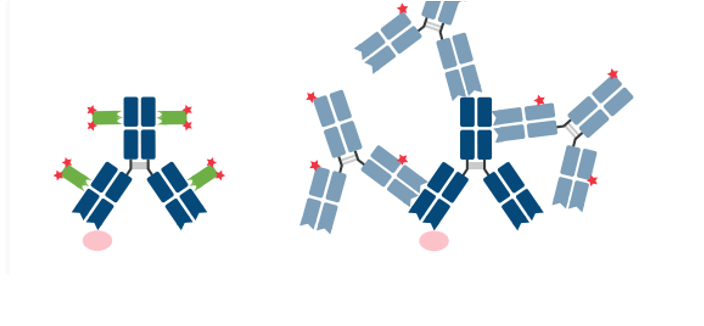
Left: primary antibody (dark blue) & Nano-secondary (green) complex. Right: primary antibody (dark blue) and conventional polyclonal secondary antibody (light blue) complex. Epitope is shown in pink and conjugated fluorescent dyes are shown in red.

HeLa cells were immunostained with rabbit anti-Lamin B1 antibodies and Nano-Secondary alpaca anti-rabbit IgG recombinant VHH Alexa Fluor® 568 (srbAF568-1). Confocal and gated STED images were acquired with a Leica TCS SP8 STED 3X microscope, pulsed depletion with a 775 nm laser. Images were recorded at the Core Facility Bioimaging at the Biomedical Center, LMU Munich.
5. Type of conjugate – The choice of the conjugate for a secondary antibody primarily depends on two factors: (i) the application in which the secondary antibody will be used, and (ii) the detection method that will be used in that application. An example of this is when performing a western blot, while an HRP-labeled secondary antibody is used for chemiluminescent detection, a fluorescent dye-labeled secondary antibody is recommended for fluorescent detection. The table below highlights suggested secondary antibody conjugates based on the intended application and method of detection.
|
Application |
Secondary Antibody Conjugates |
|
Western blot |
• Enzyme labeled secondaries, e.g., HRP for chemiluminescent detection and AP for colorimetric detection • Fluorescently labeled secondaries for fluorescent detection |
|
Immunohistochemistry |
• Enzyme labeled secondaries for chromogenic IHC (e.g., HRP or HRP-polymer) • Biotinylated secondaries for signal amplification • Fluorescently labeled secondaries for fluorescent IHC |
|
Immunofluorescence |
• Fluorescently labeled secondaries • HRP-labeled secondaries for TSA-based detection |
|
Flow cytometry |
• Fluorescently labeled secondaries • Enzyme labeled secondaries • Biotinylated secondaries for use with fluorescent-labeled streptavidin |
|
ELISA |
• Biotin labeled secondaries • Enzyme labeled secondaries |
6. Cross-adsorbed antibodies – Cross-adsorbed secondary antibodies are traditional polyclonal secondaries that have undergone additional purification steps to eliminate cross-reactivity against unintended IgGs from non-target species. Cross-reactivity can lead to high background or non-specific signal when the secondary antibody binds to endogenous immunoglobulins in the sample or to off-target antibodies in multiplexing applications, respectively. Cross-adsorption helps improve antibody specificity by passing affinity-purified polyclonal secondaries through a column containing immobilized antibodies or serum proteins from other species. This helps capture non-specific antibodies in the column while allowing those with no cross-reactivity to be collected in the flow-through.
Proteintech’s Multi-rAb Recombinant Secondary Antibodies are a mixture of recombinant monoclonal antibodies that have been carefully selected for minimal cross-reactivity against IgGs from off-target species. Therefore, with Multi-rAb secondaries you can achieve the same level of enhanced species specificity and reduced background as with highly cross-adsorbed traditional polyclonal secondary antibodies.
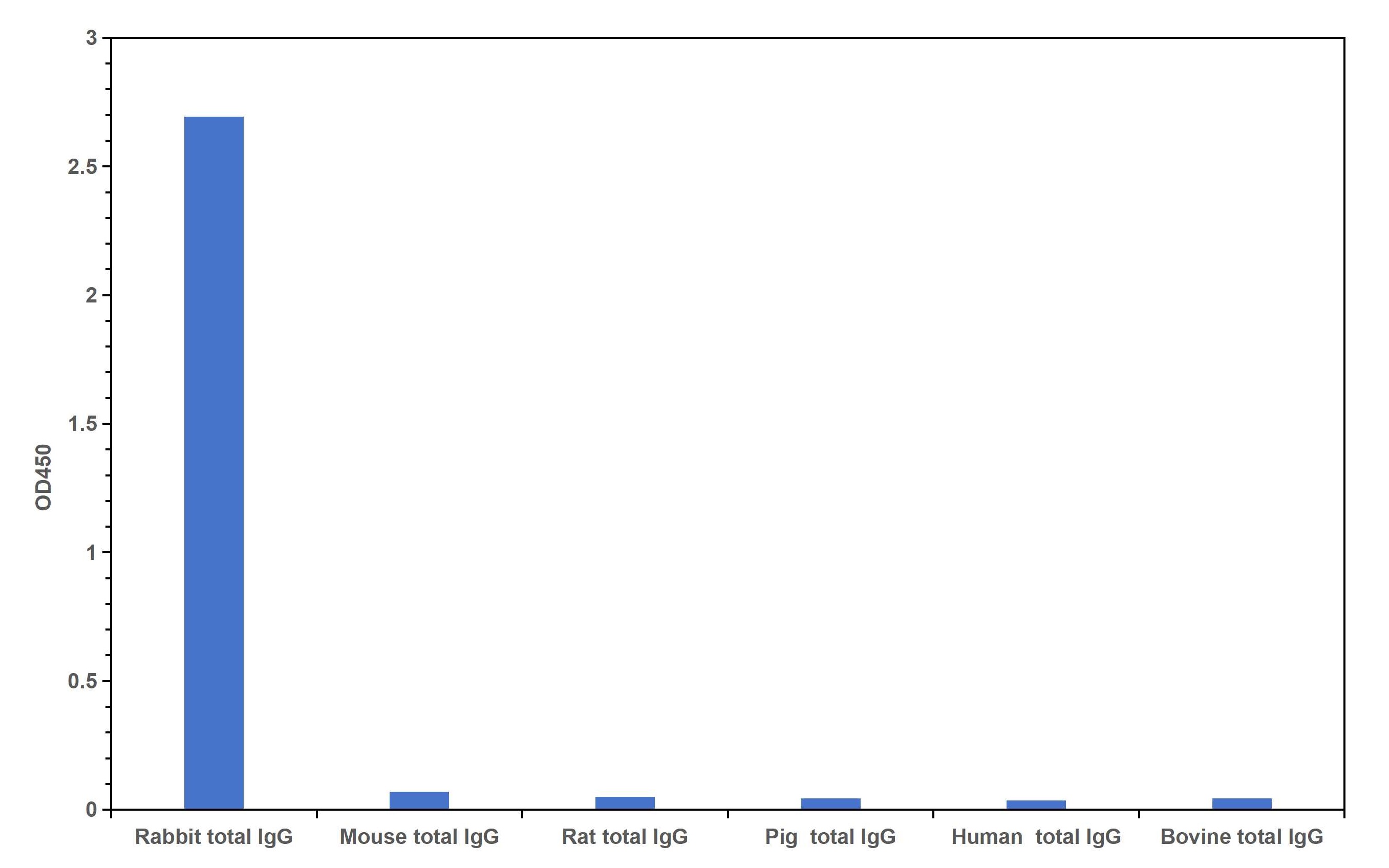
Rabbit total IgG, Mouse total IgG, Rat total IgG, Pig total IgG, Human total IgG, Bovine total IgG were coated at 100 ng/well. 0.125 μg/mL of Multi-rAb HRP-Goat Anti-Rabbit Recombinant Secondary Antibody (H+L) (RGAR001) was used for detection. The result indicates that RGAR001 is highly specific for rabbit IgG and does not react with other species tested in the experiment.

